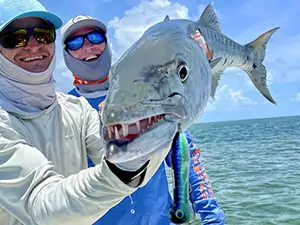Big Pine Key Fishing Charters
Big Pine Key fishing charters give you a shot at Lower Florida Keys tarpon, bonefish, and permit on the flats, reef trips for yellowtail and muttons, and offshore runs to mahi-rich bluewater—with far less boat traffic than Key West.
Top Rated Charters in Big Pine Key
TrustedFish connects anglers with proven local captains in Big Pine Key, Florida —no commissions, no pay-to-play listings, no BS. Every charter on our platform is invite-only, vetted for skill, local knowledge, and reputation. If they’re listed, they’ve earned it.
Big Pine Key, FL Fishing Guide
Fishing out of Big Pine Key puts you square in the middle of the Lower Florida Keys fishery, without the pressure and crowds of the busier islands. Local charters launch from ramps and marinas like the Old Wooden Bridge, Spanish Harbor, or Big Pine Fishing Lodge. You’re minutes from tarpon bridges, permit flats, and the reefline at Looe Key.
Backcountry and inshore fishing dominate most half-day trips. Expect sight-casting to bonefish and permit across the flats near Coupon Bight and Little Torch. Spring through summer, tarpon stack up in Bahia Honda Channel—drift live crabs on the outgoing tide or toss jigs after dark under the bridge lights. Fly anglers will find plenty of clean shots on calm mornings.
Big Pine Key deep sea fishing trips usually head 10 to 20 miles offshore past Looe Key to troll for mahi, blackfin tuna, and the occasional sailfish. Color changes, weedlines, and floating debris are the key. Most boats troll ballyhoo, feathers, or deep-divers. When the offshore slows or weather turns, reef fishing turns on—anchor up, chum hard, and drift cut bait for yellowtail, mangrove, and mutton snapper. Deeper ledges hold grouper when the season’s open.
This part of the Florida Keys gives you options. Inshore, offshore, or reef—your charter can flex with the weather and tide. And with fewer boats working the area, the bite often stays fresher.
Fishing Seasons in Big Pine Key
Spring (March–May)
Tarpon stack in Bahia Honda by March. Permit and bonefish tail on the flats. Offshore boats start hitting blackfin tuna and early mahi near the reef edge.
Summer (June–August)
Peak mahi season offshore—look for them 15–25 miles out on weedlines. Flats fishing stays strong early and late. Reef snapper action is nonstop, especially for yellowtail.
Fall (September–November)
Lighter winds and cooler temps bring excellent mutton and grouper bites on structure. Blackfin tuna return offshore. Permit and bonefish still feed on sunny flats.
Winter (December–February)
Cool water pushes trout, pompano, and jacks into the backcountry. Offshore deep dropping takes over—tilefish and snowy grouper. Reef snapper stay consistent in calmer pockets.
Gamefish in Big Pine Key
- Tarpon – 40–150 lbs Peak March–June in Bahia Honda Channel. Drift live crabs or mullet on outgoing tide. Night bites on jigs under bridges.
- Permit – 10–30 lbs Sight-fished on flats near Coupon Bight and wrecks nearby. Crabs on jigheads or fly gear in calm, sunny conditions.
- Bonefish – 3–8 lbs Targeted year-round on hard-bottom flats with live shrimp or small jigs. Best on incoming tides with light wind.
- Mahi-Mahi – 5–25 lbs May–August offshore past the reef. Troll ballyhoo near debris or weed patches, or cast jigs to surfacing fish.
- Blackfin Tuna – 5–20 lbs Spring and fall offshore near humps and color breaks. Troll feathers or vertical jig deeper marks.
- Yellowtail Snapper – 1–4 lbs Reef staple caught year-round. Anchor, chum, and drift small chunks of bait on light leader into the slick.
- Mutton Snapper – 5–15 lbs Found near deeper wrecks and edges. Fish the bottom with live pinfish or cut bait on a knocker or fish-finder rig.
- Mangrove Snapper – 1–3 lbs Common inshore and on shallow reefs. Night fishing near bridges with live shrimp or pilchards is deadly.
- Grouper (Black, Red, Gag) – 10–30 lbs Hold near reef ledges and deep structure. Drop live bait on heavy tackle. Seasonally closed January–April.
Big Pine Key Fishing FAQs
What makes Big Pine Key fishing different from the rest of the Florida Keys?
Big Pine gives you access to the same tarpon, flats, and offshore zones—but with fewer boats and quieter water. It’s a top choice for serious anglers who want space.
Are Florida fishing licenses included with Big Pine Key charters?
Yes—when you book a licensed charter boat, your fishing license is covered under their commercial license.
When is the best time to fish the Florida Keys from Big Pine Key?
March to August is prime—tarpon, bonefish, mahi, and reef snapper are all in play. Fall offers calmer water and fewer crowds.
How far offshore do Big Pine Key deep sea fishing charters go?
Most trips run 10 to 25 miles offshore, just past the reefline. Far enough for mahi and tuna, but short enough to keep rods bent.
Can I fly fish in the Lower Florida Keys?
Yes—Big Pine is a top destination for fly anglers targeting bonefish, permit, tarpon, and barracuda on clear flats.
Is Bahia Honda the best spot for tarpon in the Keys?
It’s one of the best. The Bahia Honda Channel holds massive migratory fish from March through June, especially on outgoing tides.
Do charters in Big Pine Key offer reef and offshore combo trips?
Many do. With short runs, you can fish the reef for snapper in the morning and chase mahi offshore in the afternoon.
What kind of boats do Florida Keys charters use in Big Pine?
Flats skiffs, bay boats, and center consoles are most common. Some reef and offshore trips run larger sportfish or twin-engine vessels.
Are there kid-friendly fishing charters in Big Pine Key?
Yes—many charters offer easy reef or mangrove trips targeting snapper and jacks. Calm water and constant action make it great for families.

